[ad_1]
Do you want to update WordPress but don’t know where to start? Often beginners are afraid that an update may break their website.
This fear is understandable. However, it’s important to use the latest version of WordPress for the best website security and performance.
In this beginner’s guide, we will show you how to safely update WordPress like a pro without breaking your website.
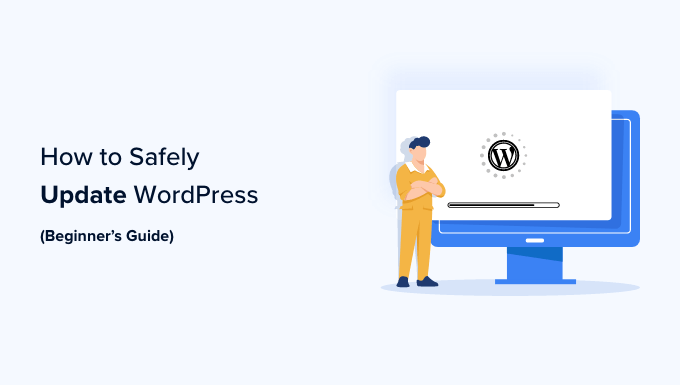
Upgrading your WordPress website is a regular maintenance task. We have created an easy-to-follow infographic that you can use as a reference guide.
Just click on the image below to view the full infographic, or continue reading the text instructions.
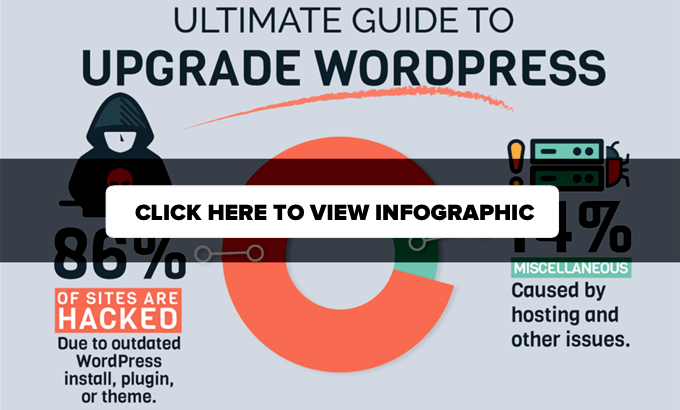
Why Should You Always Update WordPress?
Leading WordPress security research shows that the majority of WordPress websites that get hacked have outdated WordPress core, plugins, or themes.
WordPress is actively maintained by developers from all over the world. These developers find and fix bugs, add new features, and hunt down security vulnerabilities on a regular basis. These changes are then released in a new WordPress version.
If it is not a big release, then WordPress can automatically update itself to the newer version. For major releases, unless you are on managed WordPress hosting, you will have to manually initiate the update yourself.
You need to update to make sure that your website has the latest security patches, the newest features, and the best speed and performance.
You can learn more on this important topic in our guide on why you should always use the latest version of WordPress.
That being said, let’s take a look at how to safely update WordPress to the latest version.
Things to Do Before Updating WordPress
The most important thing you need to do before upgrading WordPress is to create a complete WordPress backup.
Even if you have an automated WordPress backup plugin set up like Duplicator, you still need to create a new backup and store it safely in a remote location, such as your computer or cloud storage like Google Drive.
A complete WordPress backup includes everything:
Your WordPress databaseAll your images and media uploadsYour WordPress plugins and themesYour WordPress configuration filesCore WordPress files
This step is crucial as it will allow you to restore WordPress from the backup in case something goes wrong.
Once you have created a complete backup and stored it remotely, then you can move on to the next step.
Updating WordPress to the Latest Version
There are two easy ways to upgrade your WordPress site to the latest version. One is automatic, and the other one is manual. We will show you both of them.
Method 1: Updating WordPress Using the Built-in System (1-Click)
This method is easier and is recommended for all users.
First, log in to the admin area of your WordPress website and go to the Dashboard » Updates page.
You will see the notice that a new version of WordPress is available. Now you just need to click on the ‘Update to version X.X.X’ button to initiate the upgrade.
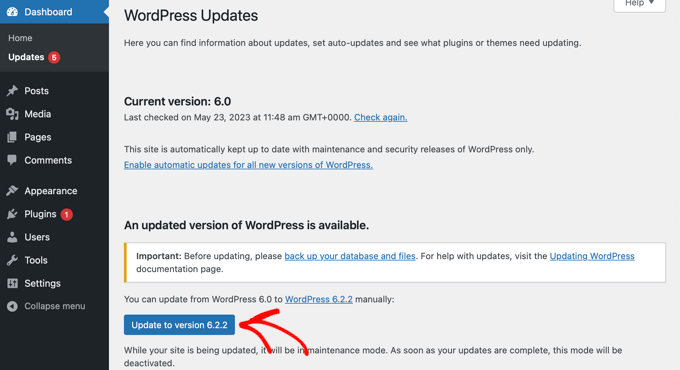
WordPress will now fetch the latest version of the software and install it for you.
You will see the update progress on your screen. During the upgrade, WordPress will put your site into maintenance mode.
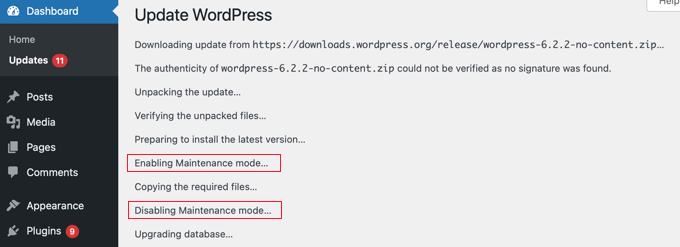
Your site will still be visible to users, but you can’t install plugins or themes while the update is underway.
Once the update is over, you will be redirected to the WordPress welcome screen. Depending on each release, you may see a page explaining what’s new in WordPress and the features you should try.
That’s all; you have successfully upgraded WordPress to the latest version.
Method 2: Manually Update WordPress Using FTP
This method requires you to use FTP to manually upload WordPress files. You can use this if the first method doesn’t work.
First, you will need to download the latest version of WordPress. Head over to the WordPress download page and click on the ‘Download’ button.
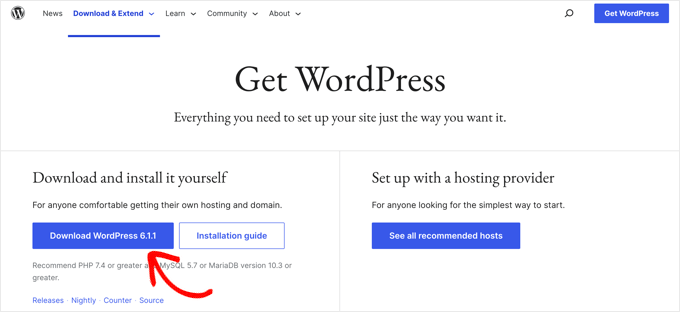
Your browser will now download WordPress in a zip file. Once downloaded, you need to extract the zip file.
Inside you will see a wordpress folder. This folder contains all the WordPress files you need for the update.
Next, you need to open your FTP client and connect to your website. Once connected, go to the wordpress folder you just extracted from the zip file in the local files column.
In the remote files column, go to your website’s root folder. This folder could be public_html or named after your website’s domain name. Inside this folder, you will see your WordPress files and folders.
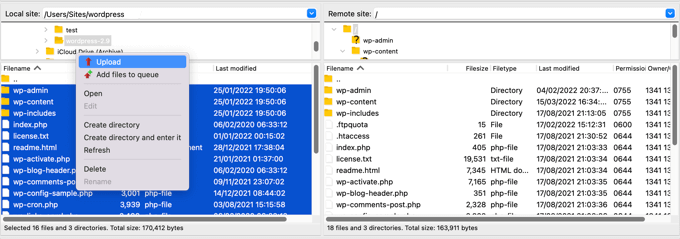
You should select all files inside the wordpress folder on your computer and then right-click to select ‘Upload’.
Your FTP client will now start uploading WordPress files from your computer to your website.
However, your website already has older versions of the files with the same name. You will be asked what you want to do with those files. You need to select ‘Overwrite’ and check the box next to ‘Always use this action’.
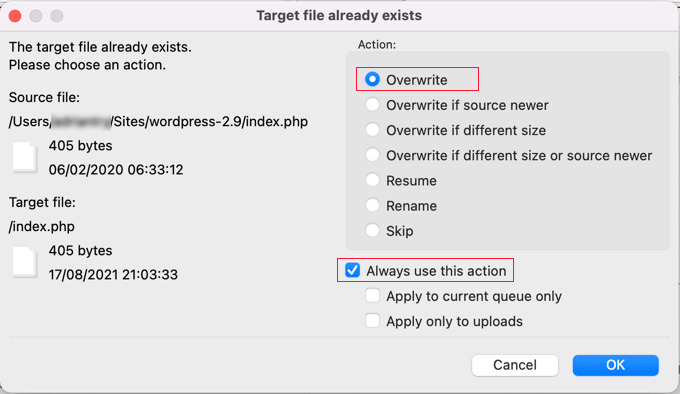
This will ensure that all WordPress files on your website are replaced by the newer versions.
Once the upload is finished, you need to go to the admin area of your WordPress site. This step is necessary because sometimes, a newer version of WordPress may also need to update your WordPress database.
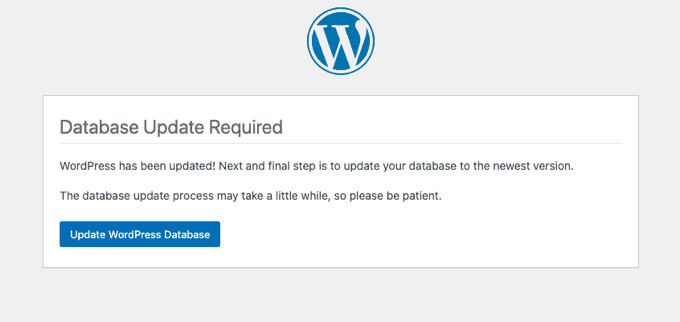
In that case, you may see a page mentioning that a database update is required. Simply click the ‘Update WordPress Database’ button to continue.
That’s all; you have successfully updated your WordPress website.
Things to Do After Updating WordPress
Once you have upgraded WordPress on your website, you need to make sure that everything is working as expected. Simply visit your website in a new browser window and review the settings in the WordPress admin area.
If you come across any issues, then take a look at our list of common WordPress errors and how to fix them. If the issue you are facing is not listed there, then follow the steps in our WordPress troubleshooting guide to figure out the problem and apply a solution.
We hope this article helped you update WordPress to the latest version. You may also want to see our step-by-step WordPress SEO guide for beginners or our expert picks for the best analytics solutions for WordPress users.
If you liked this article, then please subscribe to our YouTube Channel for WordPress video tutorials. You can also find us on Twitter and Facebook.
The post Beginner’s Guide: How to Safely Update WordPress (Infographic) first appeared on WPBeginner.
[ad_2]
Source link
